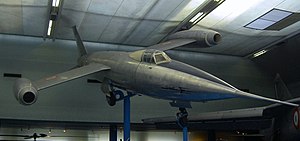SNCASO Trident: Difference between revisions
→Design and development: loss of '001' airframe during test |
|||
| Line 26: | Line 26: | ||
Test flights of the SO.9000 were described by the author [[Bill Gunston]] as 'hairy' until the rocket motor was added in September 1954. During the 18-month test programme the aircraft completed over 100 flights, eventually reaching a speed of [[Mach number|Mach]] 1.8 and an [[altitude]] of 20,000 metres (65,000 ft).<ref name="Gunston"/> |
Test flights of the SO.9000 were described by the author [[Bill Gunston]] as 'hairy' until the rocket motor was added in September 1954. During the 18-month test programme the aircraft completed over 100 flights, eventually reaching a speed of [[Mach number|Mach]] 1.8 and an [[altitude]] of 20,000 metres (65,000 ft).<ref name="Gunston"/> |
||
The first Trident II, ''001'', was destroyed on 21 May 1957 during a test-flight out of ''Centre d'Essais en Vol'' (Flight Test Center) when its highly volatile fuels, [[Furaline]] and [[nitric acid]], accidentally mixed and exploded, killing test pilot Charles Goujon. Project is discontinued following this accident.<ref name="Jackson, Robert 1986, page 91"/> <ref>[http://www.flightglobal.com/pdfarchive/view/1957/1957%20-%200734.html ''Flight,'' 1957] Retrieved: 15 October 2010</ref> In 1958, the Trident II set time to height and altitude records. Its record altitude of 24,300 m in May was made by Roger Carpentier<ref>[http://www.flightglobal.com/pdfarchive/view/1958/1958%20-%200607.html "Trident's 79,720ft"]</ref> |
|||
The project was cancelled in July 1957; the decision was influenced by the [[1957 Defence White Paper|manned fighter cuts]] announced by the British [[Minister of Defence|Defence Minister]], [[Duncan Sandys]].<ref name="Gunston"/> |
The project was cancelled in July 1957; the decision was influenced by the [[1957 Defence White Paper|manned fighter cuts]] announced by the British [[Minister of Defence|Defence Minister]], [[Duncan Sandys]].<ref name="Gunston"/> |
||
Revision as of 05:05, 24 August 2016
| SO.9000/SO.9050 Trident | |
|---|---|

| |
| Role | Research interceptor aircraft |
| National origin | France |
| Manufacturer | SNCASO |
| First flight | 2 March Template:Avyear |
| Number built | 12 |
The SNCASO SO.9000 Trident was a mixed power French prototype interceptor aircraft of the 1950s. Capable of supersonic flight the project was cancelled in July 1957 after only 12 examples had been built.
Design and development
The French Air Staff tasked SNCASO to develop a point defence interceptor, studies began in October 1948.[1] The aircraft that emerged was a shoulder wing monoplane, to be primarily powered by a SEPR rocket engine and augmented with wing-tip mounted turbojets. First flown on 2 March 1953 by test pilot Jacques Guignard the aircraft used the entire length of the runway to get airborne powered only by its turbojets.[1] From March 1955 the Trident I flew with new turbojets, the more powerful Dassault-built MD 30 Viper ASV.5, which produced 7.34 kN (1,654 lbf) thrust each. With these engines it soon exceeded Mach 1 in a shallow dive without rocket power.[2]
Test flights of the SO.9000 were described by the author Bill Gunston as 'hairy' until the rocket motor was added in September 1954. During the 18-month test programme the aircraft completed over 100 flights, eventually reaching a speed of Mach 1.8 and an altitude of 20,000 metres (65,000 ft).[1]
The first Trident II, 001, was destroyed on 21 May 1957 during a test-flight out of Centre d'Essais en Vol (Flight Test Center) when its highly volatile fuels, Furaline and nitric acid, accidentally mixed and exploded, killing test pilot Charles Goujon. Project is discontinued following this accident.[3] [4] In 1958, the Trident II set time to height and altitude records. Its record altitude of 24,300 m in May was made by Roger Carpentier[5]
The project was cancelled in July 1957; the decision was influenced by the manned fighter cuts announced by the British Defence Minister, Duncan Sandys.[1]
Variants
- SO.9000 Trident I
Two aircraft built. The first aircraft was built at Istres and was completed in late-1952, the second aircraft 02 crashed on its first flight in September 1953. Three-chamber SEPR 481 rocket engine, each chamber producing 2,755 lbf (12,250 N) thrust.
- SO.9050 Trident II
Ten pre-production aircraft ordered in 1953. Higher power, 11.77 kN (2,645 lbf), Turbomeca Gabizo turbojets, with a two-chamber SEPR 631 rocket engine (each chamber now being individually ignited for finer thrust control). First flight 21 December 1955.
Aircraft on display
The preserved SO.9000-01 Trident has been on public display since 1956 at the Musée de l'Air et de l'Espace, near Paris.
Specifications (SO.9000)

Data from Gunston[6] Rothmund[7]
General characteristics
- Crew: 1
- Length: 14 m (45 ft 11 in)
- Wingspan: 8.15 m (26 ft 9 in)
- Height: 3.17 m (10 ft 5 in)
- Wing area: 14.5 m2 (156 sq ft)
- Empty weight: 3,350 kg (7,385 lb)
- Gross weight: 5,500 kg (12,125 lb)
- Powerplant: 2 × Turbomeca Marboré centrifugal flow turbojet, 3.9 kN (880 lbf) thrust each
- Powerplant: 1 × SEPR 481 liquid-fuelled triple chamber rocket engine, 12.37 kN (2,780 lbf) thrust per chamber
Performance
- Maximum speed: 1,707 km/h (1,061 mph, 922 kn)
- Maximum speed: Mach 1.6
See also
Aircraft of comparable role, configuration, and era
References
Notes
- ^ a b c d Gunston 1981, pp. 218—219.
- ^ Jane's All the World's Aircraft 1956/7, pages 154-5
- ^ Cite error: The named reference
Jackson, Robert 1986, page 91was invoked but never defined (see the help page). - ^ Flight, 1957 Retrieved: 15 October 2010
- ^ "Trident's 79,720ft"
- ^ Gunston 1981, p. 219.
- ^ IAC-04-IAA-6.15.3.02 REUSABLE MAN-RATED ROCKET ENGINES The French Experience, 1944-1996
Bibliography
- Bridgman, Leonard (1956). Jane's All the World's Aircraft 1956-57. London: Jane's All the World's Aircraft Publishing Co. Ltd.
{{cite book}}: Cite has empty unknown parameter:|coauthors=(help); Invalid|ref=harv(help) - Gunston, Bill. Fighters of the Fifties. Cambridge, England. Patrick Stephens Limited, 1981. ISBN 0-85059-463-4
- Taylor, John W.R. Jane's Pocket Book of Research and Experimental Aircraft, London, Macdonald and Jane's Publishers Ltd, 1976. ISBN 0-356-08409-4.
External links
